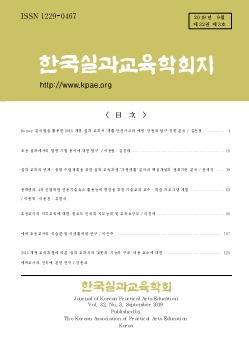학술논문
손잡이를 고려한 ‘손가락에 실을 감아 시작매듭 짓기’ 교육
이용수 55
- 영문명
- Education with Handedness on ‘Making a Knot by Winding a Thread on a Finger When Starting Hand Sewing’
- 발행기관
- 한국실과교육학회
- 저자명
- 정지윤(Jung, Ji Yoon) 이동원(Lee, Dong Won)
- 간행물 정보
- 『한국실과교육학회지』제32권 제4호, 65~97쪽, 전체 33쪽
- 주제분류
- 사회과학 > 교육학
- 파일형태
- 발행일자
- 2019.12.30
6,760원
구매일시로부터 72시간 이내에 다운로드 가능합니다.
이 학술논문 정보는 (주)교보문고와 각 발행기관 사이에 저작물 이용 계약이 체결된 것으로, 교보문고를 통해 제공되고 있습니다.

국문 초록
손잡이를 고려한 ‘손가락에 실을 감아 시작매듭 짓기’ 교육을 통해 예비초등교사로서 다양한 손잡이 가능성을 발견하고, 미래의 초등교육의 현장에서 손잡이의 다양성을 고려한 교육을 할 수 있는 능력 개발을 목적으로 실과 의생활교육 관련 과목을 수강하는 교육대학교 1학년 184명을 대상으로 손잡이를 분석하고, 다양한 손잡이를 고려한 ‘손가락에 실을 감아 시작매듭짓기’ 교육을 하는 수업 전과 후의 차이를 빈도, 교차분석, x² 검정으로 분석하고, 손잡이에 따른 ‘손가락에 실을 감아 시작매듭 짓기’ 교육 방법을 제안하였다.
수업 전, ‘손가락에 실을 감아 시작매듭 짓기를 할 수 있다’고 한 집단(112명)에서 ‘실을 감는 손가락의 손’은 손잡이 집단에 따른 ‘손가락에 실을 감아 시작매듭 짓기’ 수업 전에는 손잡이에 통계적으로 유의미한 차이를 보이지 않았으나, 수업 후에는 통계적으로 유의미한 차이를 보였다(p< .05). ‘손가락에 실을 감는 방향’은 수업 전과 후 모두 손잡이에 통계적으로 유의미한 차이를 보이지 않았다.
‘수업 전, 손가락에 실을 감아 시작매듭 짓기를 할 수 없다’고 한 집단(69명)에서 손잡이 집단에 따른 ‘손가락에 실을 감아 시작매듭 짓기’ 수업 후의 ‘실을 감는 손가락의 손’과 ‘손가락에 실을 감는 방향’은 손잡이에 따라 통계적으로 유의미한 차이를 보이지 않았다.
전체 집단의 손잡이 집단에 따른 ‘손가락에 실을 감아 시작매듭 짓기’ 수업 후의 ‘실을 감는 손가락의 손’은 손잡이에 따라 통계적으로 유의미한 차이를 보였으나(p<.05), ‘손가락에 실을 감는 방향’ 통계적으로 유의미한 차이를 보이지 않았다. 이는 ‘실을 감는 손가락의 손’이 손잡이에 더 영향을 받는 요인이며, ‘손가락에 실을 감는 방향’은 손잡이에 큰 상관없이 시계방향이나 반시계방향으로 편한 쪽으로 한다는 것을 알 수 있었다.
손잡이에 의한 불편함 없는 ‘손가락에 실을 감아 시작매듭 짓기’ 수업을 위해 실을 오른손 집게손가락 또는 왼손 집게손가락에 시계 방향이나 반시계 방향으로 감는 4가지 방법을 제안하였다.
영문 초록
Education on ‘making a knot by winding a thread on a finger when starting hand sewing’ began with a brief explanation in the 4th curriculum. Illustrations were added in the 5th curriculum, and photographs were added after the 6th curriculum. In the 2009 and 2015 revised curriculum, a method of ‘making a knot by winding a thread in a needle when starting hand sewing’ was presented in one textbook. The textbooks of all curricula were the same as the method of ‘making a knot by winding a thread in a needle when starting hand sewing’
The subjects were right-handed (93.9%), left-handed (6.1%) and two-handed (0%). There was no statistically significant difference between the handedness and the possibility of ‘making a knot by winding a thread on a finger when starting hand sewing’.
In the group of 112 students of ‘Before class, making a knot by winding a thread on a finger when starting hand sewing’, hand of finger winding a thread’ did not show any statistically significant difference in the handedness before the class with handedness of ‘making a knot by winding a thread on a finger when starting hand sewing’. But, After class, ‘hand of finger winding a thread’ showed statistically significant differences between the handedness (p<.05). ‘the direction of winding the thread’ and the handedness showed no statistically significant difference before and after class.
In the group of 69 students of ‘Before class, not making a knot by winding a thread on a finger when starting hand sewing’, hand of finger winding a thread’ and ‘the direction of winding the thread’ did not show statistically significant difference in the handedness after the class with handedness of ‘making a knot by winding a thread on a finger when starting hand sewing’.
In the total group, ‘hand of finger winding a thread’ after the class with handedness of ‘making a knot by winding a thread on a finger when starting hand sewing’ showed a statistically significant difference, according to the handedness (p<.05), but ‘the direction of winding the thread’ did not show a statistically significant difference.
For education, we proposed four methods of winding the clockwise or counterclockwise around the right forefinger or left forefinger.
Since there is no priority or superior handedness on the handedness, the purpose of education with handedness on ‘making a knot by winding a thread on a finger when starting hand sewing’ was to provide students with various methods of ‘making a knot by winding a thread on a finger when starting hand sewing’ and taking classes without the inconvenience of the handedness. In addition, these educated prospective elementary school teachers were to develop the ability to guide students of various handedness in future primary education.
목차
Ⅰ. 서론
Ⅱ. 이론적 배경
Ⅲ. 연구의 내용 및 방법
Ⅳ. 결과 및 해석
Ⅴ. 요약 및 결론
키워드
해당간행물 수록 논문
- 초등 예비교사의 지속가능발전과 상호문화역량에 관한 연구
- 2015개정교육과정용 실과 교과서의 농업 관련 내용 분석
- 세계 전통놀이를 활용한 다문화교육 프로그램이 초등학생의 다문화 행동의도에 미치는 효과
- 손잡이를 고려한 ‘손가락에 실을 감아 시작매듭 짓기’ 교육
- 기술적 문제해결에서 학습자의 아이디어 탐색에 대한 근거이론적 연구
- 초등 실과교육과정에 대한 상대적 중요도 평가
- 초등학생이 갖추어야 할 발명 능력의 구성 요인과 학습 적용 모델
- VR(Virtual Reality)을 활용한 초등 지속가능한 식생활교육 콘텐츠 연구
- 교육대학교의 발명교육 관련 교육과정 분석
- 초등 예비교사의 식생활 안전 인식 및 역량에 관한 연구
- 초등실과 의생활 영역에서의 메이커교육의 방향 탐색
- 스토리텔링 기반의 적정기술 발명교육 프로그램이 초등학생의 배려심에 미치는 효과
- 초등학교내 생태환경교육 프로그램 개발 및 적용이 환경소양과 사회성에 미치는 영향
- 메이커 활동 기반의 실과교과 소프트웨어 교육
참고문헌
교보eBook 첫 방문을 환영 합니다!

신규가입 혜택 지급이 완료 되었습니다.
바로 사용 가능한 교보e캐시 1,000원 (유효기간 7일)
지금 바로 교보eBook의 다양한 콘텐츠를 이용해 보세요!






